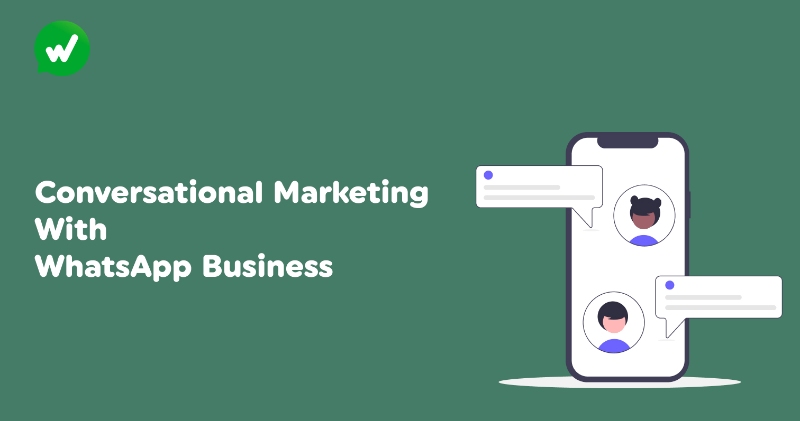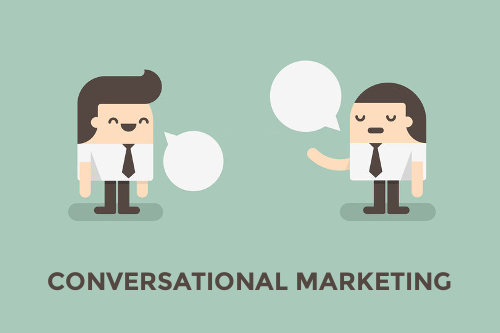
Though relatively new, conversational marketing has made its way to the forefront of many brands’ marketing strategies. What makes it tick and how can you implement it in your WhatsApp communication with your buyers? Here’s everything you need to know about conversational marketing with WhatsApp Business.
If you’ve been keeping up with the WHATSTOOL blog, then you’ll know that in an earlier post on conversational marketing, we’ve given you a brief definition of what it is.
In this guide, we’re going to dive even deeper into what conversational marketing really is, its characteristics, and what it is that makes it work so well.
Specifically, we’ll focus on using conversational marketing in chatbots and messenger apps and on WhatsApp in particular.
Why WhatsApp? That’s because (yes, if you’ve been reading our blog, you’ll have already come across this statistic) it’s the world’s most popular messaging app with more than two billion users worldwide.
What that translates into is lots of potential for engagement, sales, and business growth.
This guide will be broken down into various sections, so feel free to jump ahead to the bit(s) you’re interested in. Here’s a breakdown of the content in this post:
- What is conversational marketing (a definition)
- Main characteristics of conversational marketing
- Conversational marketing statistics
- Examples of conversational marketing
We’ve got loads to unpack here so let’s not waste any more time and get straight to it.
What Is Conversational Marketing?
To start, let’s take a quick walk down memory lane and look at conversational marketing’s roots.
Conversational marketing has actually been around for a much longer time than most people think. At its core, it’s essentially the personalized exchange of dialogue that takes place when a business interacts with its target audience.
Conversational Marketing Definition

In our previous post on conversational marketing, we presented you with its original definition coined by the company Drift.
Here it is again:
Conversational marketing or conversation marketing is a one-to-one approach to marketing that companies use to shorten their sales cycle, learn about their customers, and create a more human buying experience.
Looking at this, we can see that an interaction between a buyer and a salesperson during an in-store shopping experience or even a phone conversation in pre-eCommerce times would qualify as conversational marketing.
This would mean that conversational marketing has actually been around as early as trade itself.
And you know what? It probably was – the term was just never coined.
That said, it’s important to note that it wasn’t until chatbots and messaging apps were introduced as a communication tool for brands that the label “conversational marketing” became even more popular.
Today, it’s what most people think about when coming across the term.
The Main Characteristics of Conversational Marketing
At its root, conversational marketing is all about creating and engaging in dialogue with people who may be interested in your product. This encompasses methods like previously mentioned face-to-face interactions, video/voice calls, social media engagement, and even email marketing.
But what is it that qualifies an exchange as conversational marketing?
There’s no surprise here, but all of its characteristics are related to its root word: “conversation.”
Here are some of the main characteristics of conversational marketing:
- It takes place in real time. Like most of the conversations we have when speaking to our friends and family, conversation marketing happens live. This ensures all parties are engaged and give their full attention.
This is also why it works particularly well on WhatsApp, a chat app designed for quick exchanges and meant to bring people closer to one another.
- It’s customer-centric. Conversational marketing is customer-driven. This means that as a business, you should provide personalized engagement with your buyers – as if you were communicating with them and them only. This meaningful and personal touch and care (more on how you can communicate this in a later section), in turn, builds trust and encourages customers to the conversation going.
- It’s natural. One of the main reasons most brands turn to chatbots and messaging apps for conversational marketing is that their nature allows for dialogues to flow and develop naturally and comfortably. Exchanges via conversational marketing should never feel like it’s between two strangers.
- It’s not one-way. Unlike other forms of marketing such as paid ads, conversational marketing is bi-directional. It gives all involved parties the possibility to raise their voices whenever they want. This means that as a brand when chatting with your customer, you’re also giving them the flexibility to lead and take charge of the conversation.
3 (More) Conversational Marketing Statistics You Need To Know

In our previous post, we provided you with a few conversational marketing statistics to highlight its effectiveness. If you’re still unconvinced, here are a few more.
1. Customers Expect Chats in Real-Time
According to a recent study, 71% of customers expect companies to chat with them in real time.
This statistic stresses the importance of conversational marketing, which, implemented through chat apps, offers crystal clear and real-time communication with customers.
Not only does this allow them to ask questions whenever they need to, which boosts engagement, but it also indirectly improves the customer experience and satisfaction as a whole.
2. Live Chat Support Increases Repeat Purchases
51% of customers say they’ll purchase more from a brand if they offer live chat support.
This can be anything from engaging with automated chatbots set up to answer commonly asked questions, chatting with a human agent, or both.
Want more concrete figures? 63% of buyers with an online spending profile of between $250 and $500 online are most likely to purchase from and stay loyal to businesses with live chat support.
If your target buyers fall into this expenditure category, you may want to seriously consider building a WhatsApp chatbot for your business if you don’t already use one.
3. Consumers Are Happy To Use Messaging Apps To Reach Customer Service Teams
When it comes to getting help from a company’s customer service team, nearly eight out of ten (79%) consumers are willing to do so via messaging applications.
This is one of the most important conversational marketing statistics for several reasons.
First off, it shows the growing preference for direct communication among consumers, as older forms like email forms get increasingly less popular. Plus, it also highlights consumers’ want for quick problem resolutions instead of having to wait to hear back from the company.
By the same token, not providing messaging options would mean losing out on a massive opportunity to meet the modern consumer’s expectations.
4. 175 Million WhatsApp Messages Are Sent to Business Accounts Daily
Last but definitely not least, this conversational marketing statistic should definitely get you interested in getting started with WhatsApp Business.
According to Meta (WhatsApp’s parent company), as many as 175 million WhatsApp messages are being sent to business accounts every single day. Note that this statistic is from October 2020, just two years after WhatsApp Business was launched.
This is an extremely quick uptake, showing the popularity of conversational marketing from brands and the positive effects it has on consumers.
As WhatsApp continues to introduce new features to streamline communication, there’s no doubt more and more people around the world will start to message their favourite brands on WhatsApp.
Mastering the Art of Conversational Marketing
Now that we’ve broken down exactly what conversational marketing is and given you the statistics to back it, let’s look at how you can best implement it on WhatsApp Business.
1. Keep It Simple
There’s nothing like big words, long sentences, and massive walls of text to turn customers away.
Keep in mind that with conversational marketing, your goal is to keep your customer engaged. To do that, your conversations with them need to be as simple as possible.
Avoid filling your WhatsApp chats with your customers with wordy sentences and definitely do not spam them. Both of these run the risk of causing misunderstandings, creating animosity, and potentially losing the customer.
2. Make Use of WhatsApp’s Wide Range of Features
From WhatsApp Business’ interactive messages to multimedia tools, there are tons of features on WhatsApp that you can incorporate into your conversational marketing strategy.
For instance, calls-to-action and quick reply buttons (which are only available to WhatsApp Business API users) encourage engagement by providing easy and convenient messaging options.
The possibility to attach media files to your WhatsApp chats with buyers also helps to keep the conversation fresh and entertaining.
3. Use Emojis

There’s no question emojis form part and parcel of WhatsApp conversations. In fact, the use of emojis has been increasing over the past decade and is currently at a record high.
The informal nature of conversational marketing paves the way for the use of emojis in brands’ interactions with buyers on WhatsApp.
Now, even though this may seem like a minor and insignificant tactic, it’s actually quite a productive (and not to mention simple) way to stimulate engagement as it keeps the conversation informal and fun.
Bonus fact: The top five emojis of 2021 are the loudly crying face (😭), face with tears of joy (😂), pleading face (🥺), smiling face with hearts (🥰), and the purple heart (💜).
4. Greet Your Customers Using Their Names
With conversational marketing, you want to keep your customers at ease. So when greeting them on WhatsApp, do so with their first names.
Calling them “sir” or “madam” or even using salutations makes the conversation extremely formal and immediately erects an invisible wall that puts a distance between you and your buyer.
As an added plus, it’s also a show of confidence and comfort from your brand.
Correspondingly, you might want to consider giving your chatbot a name as it makes the exchange a lot more personal. If you have human agents attending to your incoming WhatsApp messages, they could also introduce themselves with their real (or assigned fake) names.
Examples of Conversational Marketing
Now, let’s have a look at some top examples of conversational marketing from prominent brands.
Note that even though some of them are not done via WhatsApp Business, they are still great sources of inspiration and can easily be implemented into your WhatsApp conversational marketing strategy.
1. Domino’s
Remember when ordering pizzas involved picking up a phone and actually dialling? It’s a vague memory for us too.
Thanks to chatbots, consumers can now get pizzas delivered after a few quick message exchanges.
Domino’s Pizza simplifies its pizza ordering process with conversational marketing. Aside from the casual and informal tone it adopts, the brand also makes use of different interactive message templates like quick replies to hasten orders and provide a more pleasant (and visual) user experience.
2. Munich S-Bahn
Known for its extensive network for both inter-and intra-city travel, trains are often the first choice of transportation for German residents.
Armed with that knowledge, when the Bavarian city of Munich was modernizing over 200 of its trains, city officials decided to take to conversational marketing to communicate this upgrade to passengers.
Over a period of three months, commuters were encouraged to send selfies while onboard any of their modernized trains for a chance to win its grand prize – a pair of Apple AirPods.
All they had to do was send a WhatsApp message with the keyword “Selfie” to a publicized number, along with their picture.
Note the motivating and casual way the campaign interacts with participants as well as its use of WhatsApp’s multimedia features. That’s exactly what conversational marketing is all about.
All in all, more than 600 earnest passengers took part in the campaign.
3. ADAC Don’t Call Mom
We’re going to stay in Germany for another example of conversational marketing done right.
This time, it’s Europe’s largest motoring association ADAC’s WhatsApp campaign called “Don’t Call Mom.”
Launched in 2018, the goal of this campaign was to help ADAC connect with the younger generation that didn’t (yet) own a car. (Nice forward-thinking, ADAC!)
To do that, they launched a campaign based purely on conversational marketing. Participants were encouraged to ask the ADAC team all sorts of questions – in particular, questions they wouldn’t dare ask their parents.
Behind those replies was a community team from ADAC who answered every single question directly in a personal one-to-one private chat.
The result? Thousands of shares and about 20 million new contacts for ADAC. Needless to say, it was a rousing success.
Conversational Marketing With WhatsApp Business
With all that’s been said and done in this guide, the benefits of conversational marketing with WhatsApp Business for a company couldn’t be clearer.
Even though it’s a strategy that can be implemented and executed using the free WhatsApp Business app, the API offers so many more possibilities that it would be a shame to not give it a try.
For instance, with the API, you can build more personalized exchanges with your buyers – a key trait of conversational marketing. You can also analyze these interactions and use them to further improve your communication.
That said, if you’re serious about your company’s conversational marketing game on WhatsApp, the first step would be to set up your WhatsApp Business API account.
Read Other Blogs - View


